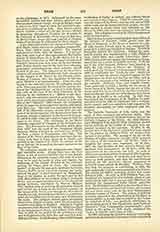

Ligamen (Lat. for bond), the existing marriage tie which constitutes in canon law a public impediment to the contracting of a second marriage. As marriage is monogamous and indissoluble, it follows that one who is still united in valid marriage cannot contract another valid marriage (Matt., v, 31 sq. xix, 4 sqq.; Mark, x, 11 sq.; Luke, xvi, 18; I Cor., vii, 10 sq.). The existence of a previous valid marriage at the moment of contracting a second entails of itself the invalidity of the latter. The Church enforces the law that no one can contract two or more marriages at the same time. Protestantism on the contrary does not take this stand as is shown, among other cases, by the action of Luther and other reformers in the case of the double marriage of the Landgrave Philip of Hesse (Janssen, “History of the German People at the close of the Middle Ages“, VI (tr. London, 1908), book II, xii, 75 sqq.; Rockwell, “Die Doppelehe des Landgraf en Philipp von Hessen” (Marburg, 1904); Paulus, “Cajetan and Luther fiber die Polygamie” in “Historisch-politische Blatter”, CXXXV, 81 sqq.; Kohler “Die Doppelehe des Landgrafen Philipp von Hessen’ in “Historische Zeitschrift”, XCIV, 385sqq.). Hence he who has already contracted a marriage, in order to proceed legally with another, must prove that the first marriage tie (ligamen) no longer exists. Since marriage, apart from “matrimonium ratum” which is dissolved for one party by religious profession, is regularly dissolved by death alone, proof of this death must be established before the second marriage can validly be contracted (C. 19, X, de spousal., IV, I).
The proof of death required is either an official death certificate, issued by the parish priest or other authorized ecclesiastic, or by the proper civil official, the directors of hospitals, the military commanding officer, or satisfactory evidence from other public records and reports. The decision of a secular judge supported by a death certificate cannot ipso facto decide the question for the ecclesiastical authorities; they may, however, utilize the same. Death may be proved by two credible witnesses on their oath; by one witness of such rank or character that he is above suspicion; by hearsay witnesses, if their statements on—mate from unsuspected sources. Should such credible evidence be unattainable directly, and from ecclesiastical sources, the bishop should try as far as possible to obtain at least a moral certainty regarding the position of the contracting parties. He ought also to consider the previous marital relations of the missing party, his religious attitude, age, health, property relations with the surviving spouse, etc.
Should the bishop be unable to obtain moral certainty or should the case be extraordinary, appealmust be made to the Apostolic See (C. 8, X, qui flu sint legit., IV, 17; Cong. S. Off., 13, Mai, 1868, i.e. the “Instructio ad probandum obitum alicuius coniugis”; Sac. Cong. Inq., 18 Juli, 1900). Whoever, in spite of the certainty of an existing marriage, attempts to contract a second, commits an act juridically null and void, is guilty of the sin of bigamy, incurs the ecclesiastical penalty of infamy, and is excommunicated with a consequent refusal of the sacraments and Christian burial. Should it prove, however, that in fact the first marriage at the time of contracting the second, was really dissolved, then the second, despite bad faith, would be valid. Should the second marriage have been contracted in good faith, if only by one party, and it subsequently appear that the first spouse still lived, then the second marriage would not only be invalid but the parties to it must be separated by the ecclesiastical authorities, and the first marriage reestablished. However, the second and invalid marriage would enj oy the advantage of being putative marriage (C. 8, X, qui filii sint legit., IV, 17). This second marriage, though illegal during the lifetime of the first spouse, may be validly contracted after his or her death; indeed, should the party who acted bona fide demand it, the guilty one is then bound to contract marriage validly with the petitioner.
Since monogamy and the indissolubility of marriage are founded on the natural law, this impediment of ligamen is binding also on non-Catholics and on the unbaptized. If an unbaptized person living in polygamy become a Christian, he must keep the wife he had first married and release the second, in case the first wife is converted with him. Otherwise, by virtue of the “Pauline privilege”, the converted husband may choose that one of his wives who allows herself to be baptized (C. 8, X, de divort., IV, 19, Pius V, “Romani Pontificis”, August 2, 1571; Gregory XIII, “Populis ac nationibus”, January 25, 1585). Polygamy is likewise forbidden by the civil law, though it is much more indulgent than the Church in the dissolving of marriages and granting divorces, and often permits a new marriage where the first marriage still exists. In this matter Catholics must not-follow the civil law where it conflicts with the law of the Church.
JOHANNES BAPTIST SAGMILLER

